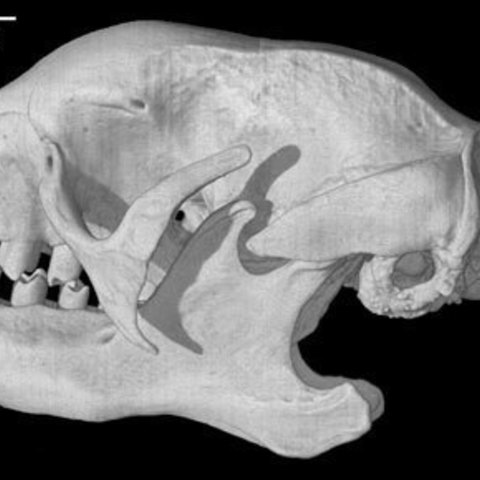
Bradypus variegatus, Three-toed Sloth skull
cults3d
Bradypus variegatus is one of just a handful of extant sloth species. The three-toed sloth, as it is commonly called, has small eyes, unnoticeable ears, and forelimbs that are about one and a half times longer then its hind limbs, giving this mammal a comic appeal. The short, blunt tail, which according to Nowak (1991) resembles 'an amputated limb,' can only add to this species' curious appearance. Adults generally reach a length of 413 to 700 mm and attain weights between 2.25 and 5.5 kg (Nowak, 1991). The coat of Bradypus consists of two types of hair, the first a short fine fur and the other long, thick guard hairs that are grooved and appear to encourage algal growth. As with Choloepus, Nowak (1991) suspects that the algae provides camouflage to the sloth as well as nutrients. Like all living sloths, Bradypus variegatus is noted for its very slow movement and strictly arboreal lifestyle. All daily life activities are carried out while upside down, including eating, sleeping, mating, and giving birth. Only urination and defecation is done on the ground and the sloth needs to descend from the trees just once a week to do so. A sluggish metabolism probably contributes to the lessened elimination needs, and as a result of the same slow, life processes Bradypus, like most other sloths, cannot maintain a constant body temperature (Nowak, 1991). This condition leads to a dependence on a consistently warm habitat such as is found in the tropical forests of Honduras to northern Argentina, where B. variegatus lives (Nowak, 1991). Overall, species in the genus Bradypus tend to be less active then the ecologically similar two-toed sloth. Individuals rarely even cross over to a neighboring tree in the course of one day, preferring to move less than a few meters (Nowak, 1991). Bradypus variegatus is a more specialized forager than Choloepus hoffmanni, feeding almost exclusively on twigs and leaves from Cecropia trees (Nowak, 1991). In addition, three-toed sloths are less social than other species, preferring to feed, sleep, and travel alone rather than in groups. Males and females probably only pair for mating, and a one to one sex ratio has been observed in the wild (Nowak, 1991). There is usually only a single young after a gestation period of 5-6 months, and while the offspring will no longer nurse after about one month, it still relies on its mother for another five (Nowak, 1991). This specimen, a male skull, was collected by the Ollala brothers on 6 June 1931 in Igarape Brabo, Rio Tapajos, Para, Brazil. It resides in the Department of Mammalogy at the American Museum of Natural History. It was made available to The University of Texas High-Resolution X-ray CT Facility for scanning by Dr. Robert Fajardo of Harvard Medical School and Dr. Timothy Rowe of The University of Texas at Austin. Funding for image processing was provided by a National Science Foundation Digital Libraries Initiative grant to Dr. Rowe.
With this file you will be able to print Bradypus variegatus, Three-toed Sloth skull with your 3D printer. Click on the button and save the file on your computer to work, edit or customize your design. You can also find more 3D designs for printers on Bradypus variegatus, Three-toed Sloth skull.
